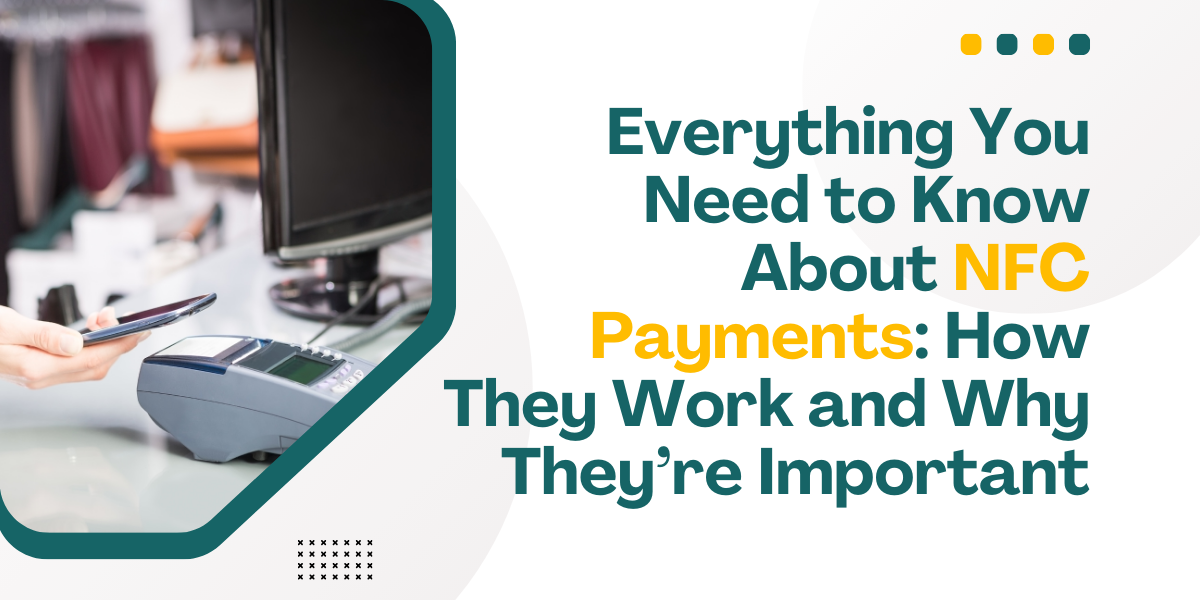NFC (Near Field Communication) technology has become a game-changer in the constantly changing world of digital payments. From contactless card payments to smartphone transactions, NFC payments offer a seamless and secure way to pay for goods and services. But what exactly are NFC payments, how do they work, and why are they essential for businesses and consumers in today’s fast-paced world? Let’s explore.
What Are NFC Payments?
NFC payments are a type of contactless payment technology that allows two devices to communicate wirelessly when they are nearby, usually within a few centimeters. These devices can be smartphones, smartwatches, or NFC-enabled credit/debit cards, and the communication happens through a secure exchange of data.
This technology leverages radio frequency identification (RFID) to enable quick and efficient data transfer. When you tap your card or phone on a payment terminal, NFC technology facilitates the transaction without requiring physical contact, PIN entry, or signatures for most transactions.
How Do NFC Payments Work?
The process of making an NFC payment is straightforward:
- NFC-Enabled Device or Card: The user must have an NFC-enabled device like a smartphone, smartwatch, or an NFC-equipped credit/debit card.
- NFC Terminal: The merchant must have a point-of-sale (POS) terminal that supports NFC technology.
- Tap-to-Pay: The user holds or taps their NFC-enabled device near the payment terminal.
- Data Transfer: Secure data exchange happens instantly between the device and the terminal.
- Transaction Authentication: Depending on the payment amount or system, the transaction may require biometric authentication, such as a fingerprint or face ID, or it may proceed without additional steps.
- Completion: The transaction is processed, and a confirmation appears on the device and/or the terminal.
This entire process takes just a few seconds, making NFC payments one of the fastest payment methods available.
Benefits of NFC Payments
NFC payments are gaining popularity due to their numerous advantages:
1. Speed and Convenience
NFC payments are incredibly quick. A simple tap or hover is all it takes to complete a transaction, reducing wait times for both consumers and merchants.
2. Enhanced Security
Transactions made via NFC are highly secure. Payment data is encrypted, and in many cases, tokenization is used to replace sensitive information with unique codes.
- Hygienic and Contactless
Especially in the post-pandemic world, contactless payments are preferred for their hygienic benefits. NFC payments eliminate the need to handle cash or touch shared surfaces like payment terminals or keypads.
4. Versatility
NFC technology is not limited to payments. It can also be used for activities like ticketing, access control, and data sharing, making it a versatile tool.
5. Wide Acceptance
With the increasing adoption of NFC-enabled POS terminals, NFC payments are now accepted at millions of locations worldwide, making them a convenient option for travelers and locals alike.
Why NFC Payments Matter
For Consumers
NFC payments offer unparalleled convenience, allowing users to leave their wallets at home and rely on their smartphones or wearables. They are ideal for those who value speed, security, and simplicity in their transactions.
For Businesses
Businesses that adopt NFC payment systems benefit from faster transaction processing, reduced checkout lines, and increased customer satisfaction. Additionally, offering contactless payment options can attract tech-savvy customers who prioritize modern and efficient payment methods.
Driving Financial Inclusion
In regions where traditional banking infrastructure is limited, NFC payments can play a crucial role in fostering financial inclusion. Mobile wallets equipped with NFC technology allow people to access payment systems without needing a traditional bank account.
Real-World Applications of NFC Payments
- Retail Stores: Many retailers offer NFC-enabled POS terminals, making it easy for shoppers to pay using their smartphones or cards.
- Public Transportation: Cities around the world use NFC technology for contactless ticketing systems, streamlining access to buses, trains, and subways.
- Events and Ticketing: NFC payments are often used for entry into events, reducing the need for physical tickets.
- Hospitality: Hotels and restaurants have adopted NFC payments to provide a seamless and contactless guest experience.
The Future of NFC Payments
The adoption of NFC payments is expected to grow rapidly in the coming years. As technology advances and more businesses embrace digital payment systems, NFC is poised to become a standard method of payment globally. Innovations like biometric authentication and integration with blockchain could further enhance the security and functionality of NFC payments.
Key Takeaways
NFC payments represent the future of digital transactions, combining speed, security, and convenience into one powerful technology. Whether you’re a consumer looking for an easier way to pay or a business aiming to stay ahead in a competitive market, NFC payments offer a compelling solution. With its growing global adoption and diverse applications, NFC technology is shaping the future of commerce in a contactless world.


![Fix MS Outlook [Pii_email_e6d3ac3a524dcd3ff672] Error Code](https://buztrendy.com/wp-content/uploads/2022/12/Outlook-Error-Code-pii_email_1a85c09ee7a236c446b6-How-To-Fix-it.jpg)
![[pii_email_b4969755ef6881519767] error?](https://buztrendy.com/wp-content/uploads/2023/01/Pii-Errors-pii_email_.png)